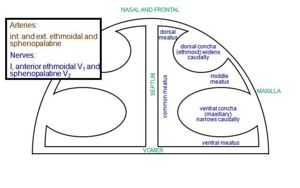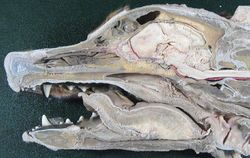Difference between revisions of "Nasal Cavity - Anatomy & Physiology"
Fiorecastro (talk | contribs) |
|||
| (7 intermediate revisions by 5 users not shown) | |||
| Line 1: | Line 1: | ||
| − | {{ | + | {{review}} |
| + | |||
| + | [[Image:Nasal Cavities.jpg|thumb|right|300px|Nasal Cavities - Copyright David Bainbridge]] | ||
==Introduction== | ==Introduction== | ||
| − | + | ||
The respiratory tract begins with the ''nose'' which includes the external nose, internal nasal cavities and [[Paranasal Sinuses - Anatomy & Physiology|paranasal sinuses]]. | The respiratory tract begins with the ''nose'' which includes the external nose, internal nasal cavities and [[Paranasal Sinuses - Anatomy & Physiology|paranasal sinuses]]. | ||
As well as being vital for transport of gases to the [[Cardiorespiratory System Overview - Anatomy & Physiology#Lower Respiratory Tract|lower respiratory tract]], the nasal cavity is also the site for one of the special senses - [[Nose - Anatomy & Physiology|''Olfaction'']]. | As well as being vital for transport of gases to the [[Cardiorespiratory System Overview - Anatomy & Physiology#Lower Respiratory Tract|lower respiratory tract]], the nasal cavity is also the site for one of the special senses - [[Nose - Anatomy & Physiology|''Olfaction'']]. | ||
==Structure== | ==Structure== | ||
| + | |||
The nose consists of the external nares with nasal [[Cartilage - Anatomy & Physiology#Structure and Function of Cartilage|cartilages]], the nasal cavity (including the nasal meatus and conchae), and the [[Paranasal Sinuses - Anatomy & Physiology|paranasal sinuses]]. | The nose consists of the external nares with nasal [[Cartilage - Anatomy & Physiology#Structure and Function of Cartilage|cartilages]], the nasal cavity (including the nasal meatus and conchae), and the [[Paranasal Sinuses - Anatomy & Physiology|paranasal sinuses]]. | ||
| Line 27: | Line 30: | ||
The conchae are [[Cartilage - Anatomy & Physiology#Types of Cartilage|cartilage]] or ossified scrolls which arise from the [[Skull and Facial Muscles - Anatomy & Physiology#Ethmoid Bone (os ethmoidale|ethmoid bone]]. They are covered with mucous membrane, under which is a layer of anastomosing blood vessels. The nasal conchae are more complex in animals with a better sense of smell, as they increase the surface area of the olfactory region, further. | The conchae are [[Cartilage - Anatomy & Physiology#Types of Cartilage|cartilage]] or ossified scrolls which arise from the [[Skull and Facial Muscles - Anatomy & Physiology#Ethmoid Bone (os ethmoidale|ethmoid bone]]. They are covered with mucous membrane, under which is a layer of anastomosing blood vessels. The nasal conchae are more complex in animals with a better sense of smell, as they increase the surface area of the olfactory region, further. | ||
| − | There are '''dorsal''' and '''ventral conchae''', the dorsal concha originating from the ethmoid bone and attaching to the maxilla, and the | + | There are '''dorsal''' and '''ventral conchae''', the dorsal concha originating from the ethmoid bone and attaching to the maxilla, and the venrtal conchae originating from the [[Skull and Facial Muscles - Anatomy & Physiology#Maxilla|maxilla]] and extending further into the nasal cavity. The conchae divide the nasal cavity into nasal ducts or '''meatuses''', which branch out from a common nasal meatus which is adjacent to the nasal septum. There are three nasal meatuses which branch from the common nasal meatus: '''dorsal''', '''middle''' and '''ventral''': |
'''Dorsal nasal meatus''' | '''Dorsal nasal meatus''' | ||
| Line 49: | Line 52: | ||
==Species Differences== | ==Species Differences== | ||
| − | The nasal cavity in the '''sheep''' is highly vascularised, with any damage to the epithelium resulting in severe [[Haemorrhage|haemorrhage]]. '''Cattle''' have a smaller nasal cavity compared to the horse. There are many variations to the entire [[Avian Respiration - Anatomy & Physiology|'''avian''' respiratory tract]]. The [[Respiration in Non-Homeotherms - Anatomy & Physiology|respiratory systems of non-homeotherms]] are also very different to that of mammals. | + | The nasal cavity in the '''sheep''' is highly vascularised, with any damage to the epithelium resulting in severe [[Haemorrhage - Pathology|haemorrhage]]. '''Cattle''' have a smaller nasal cavity compared to the horse. There are many variations to the entire [[Avian Respiration - Anatomy & Physiology|'''avian''' respiratory tract]]. The [[Respiration in Non-Homeotherms - Anatomy & Physiology|respiratory systems of non-homeotherms]] are also very different to that of mammals. |
==Links== | ==Links== | ||
| Line 55: | Line 58: | ||
Click here for information on [[Nasal Cavity - Pathology|pathology of the nasal cavity]]. | Click here for information on [[Nasal Cavity - Pathology|pathology of the nasal cavity]]. | ||
| − | |||
| − | |||
| − | |||
| − | |||
| − | |||
| − | |||
| − | |||
| − | |||
| − | |||
[[Category:Respiratory System - Anatomy & Physiology]] | [[Category:Respiratory System - Anatomy & Physiology]] | ||
[[Category:A&P Done]] | [[Category:A&P Done]] | ||
Revision as of 17:30, 7 January 2011
| This article has been peer reviewed but is awaiting expert review. If you would like to help with this, please see more information about expert reviewing. |
Introduction
The respiratory tract begins with the nose which includes the external nose, internal nasal cavities and paranasal sinuses. As well as being vital for transport of gases to the lower respiratory tract, the nasal cavity is also the site for one of the special senses - Olfaction.
Structure
The nose consists of the external nares with nasal cartilages, the nasal cavity (including the nasal meatus and conchae), and the paranasal sinuses.
Nasal cavity
The nasal cavity is essentially a tube with a wall established by several bones of the skull. The borders of the nasal cavity are as follows:
Caudal: The cribrifrom plate of the ethmoid bone.
Ventral: Continuous with the nasopharynx.
Dorsal: The maxilla and the palatine processes of the incisive bone.
Rostrally, the median septum is a continuation of the ethmoid bone. The median septum is made up of hyaline cartilage, and divides the nasal cavity into left and right halves.
Nasal conchae
The nasal cavity is occupied to a large extent by nasal conchae. These are turbinate bones which project into the nasal cavity with the purpose of supporting the olfactory mucus membranes and increasing the respiratory surface area, creating turbulence within the passing air. This helps to filter and warm or cool the air that passes through.
The conchae are cartilage or ossified scrolls which arise from the ethmoid bone. They are covered with mucous membrane, under which is a layer of anastomosing blood vessels. The nasal conchae are more complex in animals with a better sense of smell, as they increase the surface area of the olfactory region, further.
There are dorsal and ventral conchae, the dorsal concha originating from the ethmoid bone and attaching to the maxilla, and the venrtal conchae originating from the maxilla and extending further into the nasal cavity. The conchae divide the nasal cavity into nasal ducts or meatuses, which branch out from a common nasal meatus which is adjacent to the nasal septum. There are three nasal meatuses which branch from the common nasal meatus: dorsal, middle and ventral:
Dorsal nasal meatus The passage between the roof of the nasal cavity and the dorsal nasal concha.
Middle nasal meatus Between the dorsal and ventral conchae, it communicates with the paranasal sinuses.
Ventral nasal meatus The main pathway for airflow leading to the pharynx, it is positioned between the ventral nasal concha and the floor of the nasal cavity.
Common nasal meatus The longitudinal space on either side of the nasal septum.
The paranasal sinuses are extensions of the nasal cavity.
Function
In addition to olfaction, the function of the nasal cavity is to modify the incoming air before it is transported further down the respiratory tract. Air is warmed as it passes over the highly vascularised mucosal surfaces of the conchae, humidified by the evaporation from nasal secretion and cleaned as it contacts the secretion from mucus glands within the nasal cavity. The mucus secreted from the glands traps particles and cilia transport them down to the pharynx for swallowing, this process is known as the mucociliary escalator. The nasal cavity offers further protection via the sneezing reflex .
Species Differences
The nasal cavity in the sheep is highly vascularised, with any damage to the epithelium resulting in severe haemorrhage. Cattle have a smaller nasal cavity compared to the horse. There are many variations to the entire avian respiratory tract. The respiratory systems of non-homeotherms are also very different to that of mammals.
Links
Click here for information on pathology of the nasal cavity.

